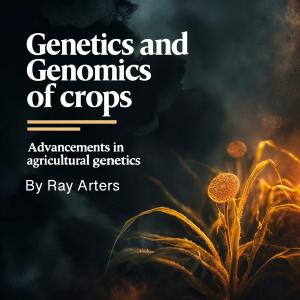

Genetics and Genomics of Crops
Ray Arters
This audiobook is narrated by a digital voice.
The transformation of wild plants into domesticated crops represents one of humanity's most profound achievements, fundamentally altering both human civilization and the genetic architecture of the species we depend upon for sustenance. This process of domestication, which began independently in multiple regions around the world approximately 10,000 years ago, involved the gradual accumulation of genetic changes that made wild plants more suitable for human cultivation and consumption.
The domestication syndrome describes a suite of traits that distinguish crops from their wild ancestors, including synchronized ripening, reduced seed dispersal, increased seed size, and loss of seed dormancy. These traits emerged through both conscious and unconscious selection by early farmers who repeatedly chose plants with characteristics that made them easier to grow, harvest, and process. The genetic basis of domestication traits often involves relatively simple changes, sometimes single gene mutations, that have profound effects on plant phenotype and agricultural utility.
Wheat domestication exemplifies the complexity of crop evolution, involving multiple species and genomic events that created the polyploid wheat varieties we cultivate today. The evolution of bread wheat involved hybridization events between different grass species, followed by chromosome doubling that created stable polyploid genomes. These genomic changes not only enabled wheat cultivation in diverse environments but also provided the genetic redundancy that allows continued breeding improvements while maintaining essential functions.
Duration - 43m.
Author - Ray Arters.
Narrator - Digital Voice Archie G.
Published Date - Friday, 24 January 2025.
Copyright - © 2025 Ray Arters ©.
Location:
United States
Description:
This audiobook is narrated by a digital voice. The transformation of wild plants into domesticated crops represents one of humanity's most profound achievements, fundamentally altering both human civilization and the genetic architecture of the species we depend upon for sustenance. This process of domestication, which began independently in multiple regions around the world approximately 10,000 years ago, involved the gradual accumulation of genetic changes that made wild plants more suitable for human cultivation and consumption. The domestication syndrome describes a suite of traits that distinguish crops from their wild ancestors, including synchronized ripening, reduced seed dispersal, increased seed size, and loss of seed dormancy. These traits emerged through both conscious and unconscious selection by early farmers who repeatedly chose plants with characteristics that made them easier to grow, harvest, and process. The genetic basis of domestication traits often involves relatively simple changes, sometimes single gene mutations, that have profound effects on plant phenotype and agricultural utility. Wheat domestication exemplifies the complexity of crop evolution, involving multiple species and genomic events that created the polyploid wheat varieties we cultivate today. The evolution of bread wheat involved hybridization events between different grass species, followed by chromosome doubling that created stable polyploid genomes. These genomic changes not only enabled wheat cultivation in diverse environments but also provided the genetic redundancy that allows continued breeding improvements while maintaining essential functions. Duration - 43m. Author - Ray Arters. Narrator - Digital Voice Archie G. Published Date - Friday, 24 January 2025. Copyright - © 2025 Ray Arters ©.
Language:
English
Start
Duration:00:43:43